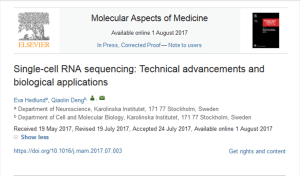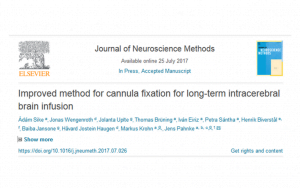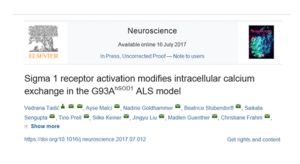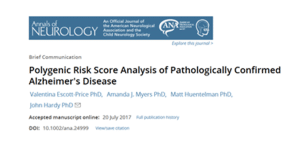 „Single-cell RNA sequencing: Technical advancements and biological applications“ has been published in Molecular Aspects of Medecine. This work was supported in part by JPND through the DAMNDPATHS project, selected in the 2013 cross-disease analysis call.
„Single-cell RNA sequencing: Technical advancements and biological applications“ has been published in Molecular Aspects of Medecine. This work was supported in part by JPND through the DAMNDPATHS project, selected in the 2013 cross-disease analysis call.
Author Archives: jpnd
Although Parkinson’s disease is often associated with motor symptoms such as stiffness, poor balance and trembling, the first symptoms are often sensory and include a reduced sense of touch and smell. In a study on mice, researchers have now been able to identify neural circuits and mechanisms behind this loss of sensory perception. The study, which was published in Neuron, may open avenues to methods of earlier diagnosis.
In this study, researchers used a light puff of air to stimulate either the right or left whiskers of mice, some of which had an especially low number of dopamine cells, while using a new optogenetic tool called an optopatcher. Applying this technique, which enables the activity of neurons to be recorded during manipulation with light, they were able to see which neurons in the basal ganglia were active and when they transmitted signals.
The researchers report that the neurons in mice with very low levels of dopamine did not properly signal in response to whisker stimulation and could not accurately tell the difference between right and left. However, after being treated with a common Parkinson’s drug called L-DOPA, this ability was regained.
The researchers say they hope that the discovery will open the way for methods of earlier diagnosis.
Reprinted from materials provided by the Karolinska Institutet.
Tau proteins are involved in more than twenty neurodegenerative diseases, including various forms of dementia. These proteins clump together in patients’ brains to form neuronal tangles: protein aggregation that eventually coincides with the death of brain cells. Researchers have now discovered how tau disrupts the functioning of nerve cells, even before it starts forming tangles.
The study was published in Nature Communications.
In healthy circumstances, tau proteins are connected to the cytoskeleton of nerve cells, where they support the cells’ structural stability. In the nerve cells of patients, however, tau is dislodged from the cytoskeleton and ultimately tangles together to form protein accumulations that disrupt the nerve cell’s functioning.
But even before these protein accumulations are formed, the dislodged tau impedes the communication between nerve cells. The researchers say that they found that across fruit flies, rats, and human patients, dislodged tau ends up at nerve cell synapses, where it hooks into vesicles and inhibits communication between different nerve cells.
The next step, the researchers say, is to see if, in animal models, they can find ways to keep tau from hooking onto vesicles and, by extension, prevent nerve cell death.
Paper: „Tau association with synaptic vesicles causes presynaptic dysfunction”
Reprinted from materials provided by: VIB – Flanders Interuniversity Institute for Biotechnology
The EU Joint Programme – Neurodegenerative Disease Research (JPND), will host a half-day workshop led by the Italian Ministry of Education, Universities and Research (MIUR) from 9 a.m. to 1 p.m. on October 12, 2017, focused on fostering cooperation in neurodegenerative disease research. The workshop will take place as part of Meet In Italy for Life Sciences, a three-day event in Turin, Italy. Registration for the meeting, which is free, is now open.
JPND has already engaged with pharmaceutical companies over the past several years and now wants to better understand other industry sectors such as diagnostic, IT, medical devices, care and imaging as well as small and medium enterprises.
With this in mind, the primary goal of the workshop is to begin a two-way conversation with industries active in the neurodegenerative disease field in order to:
- ascertain their priorities
- get their views on JPND’s current priorities
- seek consensus on industry’s requirements for collaborative activity with the academic sector and other stakeholders (e.g., funders, regulators)
The outputs of the meeting will help to foster cooperation between academia and industry in research on neurodegenerative diseases, and will serve to orient JPND’s research activity and investment over the coming decade.
A detailed agenda of the workshop will be available shortly.
For more information on the program of the workshop, please contact Valeria Cardia at [email protected] or by phone at +39 06 5849 7333.
To register for the workshop please send an e-mail to [email protected]
Registration is limited, and participants will be selected based on their area of expertise and location in order to ensure geographically diverse representation at the event.
 „Improved method for cannula fixation for long-term intracerebral brain infusion“ has been published in the Journal of Neuroscience Methods. This work was supported in part by JPND through the NeuroGEM project, selected in the 2013 cross-disease analysis call, and the PROP-AD project, selected in the 2015 JPco-fuND call.
„Improved method for cannula fixation for long-term intracerebral brain infusion“ has been published in the Journal of Neuroscience Methods. This work was supported in part by JPND through the NeuroGEM project, selected in the 2013 cross-disease analysis call, and the PROP-AD project, selected in the 2015 JPco-fuND call.
By studying cells from patients with motor neuron disease, also known as amyotrophic lateral sclerosis (ALS), researchers have revealed a detailed picture of how motor neurons — nerve cells in the brain and spinal cord that control our muscles and allow us to move, talk and breathe — decline and die.
The research, published in Cell Reports, also shows that healthy neuron-supporting cells called astrocytes may play a role in the survival of motor neurons in this type of ALS, highlighting their potential role in combating neurodegenerative diseases.
The team took skin cells from healthy volunteers and patients with a genetic mutation that causes ALS, and turned them into stem cells capable of becoming many other cell types. Using specific chemical signals, they then ‘guided’ the stem cells into becoming motor neurons and astrocytes.
Using a range of cellular and molecular techniques, the team tracked motor neurons over time to see what went wrong in the patient-derived cells compared to those from healthy people. They found that an important protein known as TDP-43 leaks out of the nucleus where it belongs, causing a chain reaction that damaged several crucial parts of the cell’s ‘machinery’. Defining the sequence of molecular events that led to motor neuron death in an experiment using human-derived cells is an important step forward.
The team suspected that astrocytes from the patients’ cells might also be affected, becoming less efficient over time and eventually dying. To test this, they mixed different combinations of healthy and ALS patient-derived motor neurons and astrocytes, and followed their fate using highly sensitive imaging approaches. They found that healthy astrocytes kept sick motor neurons alive and functioning for longer, but sick astrocytes struggled to keep even healthy motor neurons alive.
Paper: “Progressive motor neuron pathology and the role of astrocytes in a human stem cell model of VCP-related ALS”
Reprinted from materials provided by the Francis Crick Institute.
 „Sigma 1 receptor activation modifies intracellular calcium exchange in the G93AhSOD1 ALS model“ has been published in the journal Neuroscience. This work was supported in part by JPND through the SOPHIA project, selected in the 2011 Biomarkers call.
„Sigma 1 receptor activation modifies intracellular calcium exchange in the G93AhSOD1 ALS model“ has been published in the journal Neuroscience. This work was supported in part by JPND through the SOPHIA project, selected in the 2011 Biomarkers call.
By using induced pluripotent stem cells to create endothelial cells that line blood vessels in the brain for the first time for a neurodegenerative disease, researchers have learned why Huntington’s disease patients have defects in the blood-brain barrier that contribute to the symptoms of this fatal disorder. The study, which is the first induced pluripotent stem cell-based model of the blood-brain barrier for a neurodegenerative disease, was published in Cell Reports.
The blood-brain barrier protects the brain from harmful molecules and proteins. It has been established that in Huntington’s and other neurodegenerative diseases there are defects in this barrier adding to HD symptoms. What was not known was whether these defects come from the cells that constitute the barrier or are secondary effects from other brain cells.
To answer that question, researchers reprogrammed cells from HD patients into induced pluripotent stem cells, then differentiated them into brain microvascular endothelial cells — those that form the internal lining of blood vessels and prevent leakage of blood proteins and immune cells.
The researchers discovered that blood vessels in the brains of HD patients become abnormal due to the presence of the mutated Huntingtin protein, the hallmark molecule linked to the disease. As a result, these blood vessels have a diminished capacity to form new blood vessels and are leaky compared to those derived from control patients.
The chronic production of the mutant Huntingtin protein in the blood vessel cells causes other genes within the cells to be abnormally expressed, which in turn disrupts their normal functions, such as creating new vessels, maintaining an appropriate barrier to outside molecules, and eliminating harmful substances that may enter the brain.
In addition, by conducting in-depth analyses of the altered gene expression patterns in these cells, the researchers identified a key signaling pathway known as the Wnt that helps explain why these defects occur. In the healthy brain, this pathway plays an important role in forming and preserving the blood-brain barrier. The researchers showed that most of the defects in HD patients‘ blood vessels can be prevented when the vessels are exposed to a compound (XAV939) that inhibits the activity of the Wnt pathway.
Paper: „Huntington’s Disease iPSC-Derived Brain Microvascular Endothelial Cells Reveal WNT-Mediated Angiogenic and Blood-Brain Barrier Deficits”
Reprinted from materials provided by the University of California, Irvine.
 „Polygenic Risk Score Analysis of Pathologically Confirmed Alzheimer’s Disease“ has been published in the journal Annals of Neurology. This work was supported in part by JPND through the PERADES project, selected in the 2012 Risk Factors call.
„Polygenic Risk Score Analysis of Pathologically Confirmed Alzheimer’s Disease“ has been published in the journal Annals of Neurology. This work was supported in part by JPND through the PERADES project, selected in the 2012 Risk Factors call.
Many diseases, including Parkinson’s disease, can be treated with electrical stimulation from an electrode implanted in the brain. However, the electrodes can produce scarring, which diminishes their effectiveness and can necessitate additional surgeries to replace them.
Now, in a study published in Scientific Reports, researchers have demonstrated that making these electrodes much smaller can essentially eliminate this scarring, potentially allowing the devices to remain in the brain for much longer.
Many Parkinson’s patients have benefited from treatment with low-frequency electrical current delivered to a part of the brain involved in movement control. The electrodes used for this deep brain stimulation are a few millimeters in diameter. After being implanted, they gradually generate scar tissue through the constant rubbing of the electrode against the surrounding brain tissue. This process, known as gliosis, contributes to the high failure rate of such devices: About half stop working within the first six months.
Previous studies have suggested that making the implants smaller or softer could reduce the amount of scarring, so the research team set out to measure the effects of both reducing the size of the implants and coating them with a soft polyethylene glycol (PEG) hydrogel.
In mice, the researchers tested both coated and uncoated glass fibers with varying diameters and found that there is a tradeoff between size and softness. Coated fibers produced much less scarring than uncoated fibers of the same diameter. However, as the electrode fibers became smaller, down to about 30 microns (0.03 millimeters) in diameter, the uncoated versions produced less scarring, because the coatings increase the diameter. This suggests that a 30-micron, uncoated fiber is the optimal design for implantable devices in the brain.
The question now is whether fibers that are only 30 microns in diameter can be adapted for electrical stimulation, drug delivery, and recording electrical activity in the brain. Such devices could be potentially useful for treating Parkinson’s disease or other neurological disorders, the researchers say.
Paper: „Making brain implants smaller could prolong their lifespan: Thin fibers could be used to deliver drugs or electrical stimulation, with less damage to the brain.“
Reprinted from materials provided by the Massachusetts Institute of Technology.
